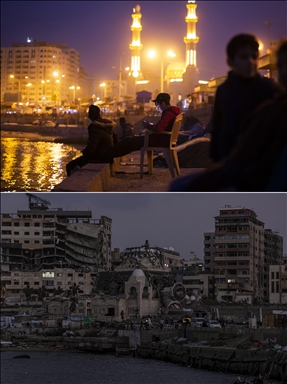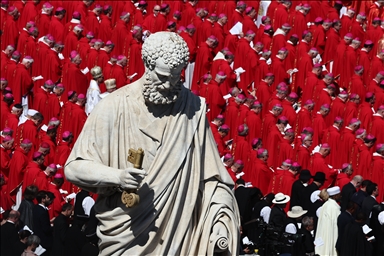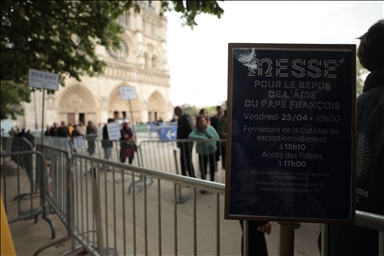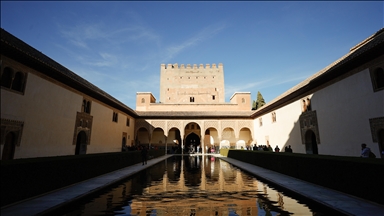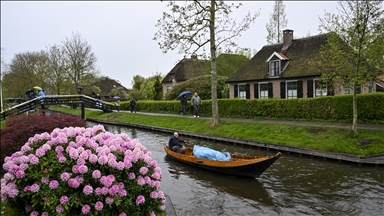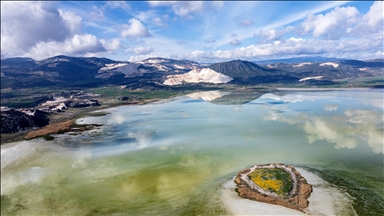
DENIZLI, TURKEY - DECEMBER 23: A view of ancient city of Hierapolis on December 23, 2018 in Denizli, Turkey. The ancient city of Hierapolis is located on a 200 meter high terrace of limestone deposits amid a wonderland of mineral water pools and petrified limestone waterfalls. The ancient city overlooks the modern town of Pamukkale in Turkey's Inner Aegean region. Founded as a thermal spa in 190 BC by Eumenes II, the King of Pergamon, the city was most likely named for Hiero, the wife of the legendary founder of the Pergamene dynasty. ( Emin Mengüarslan - Anadolu Agency )
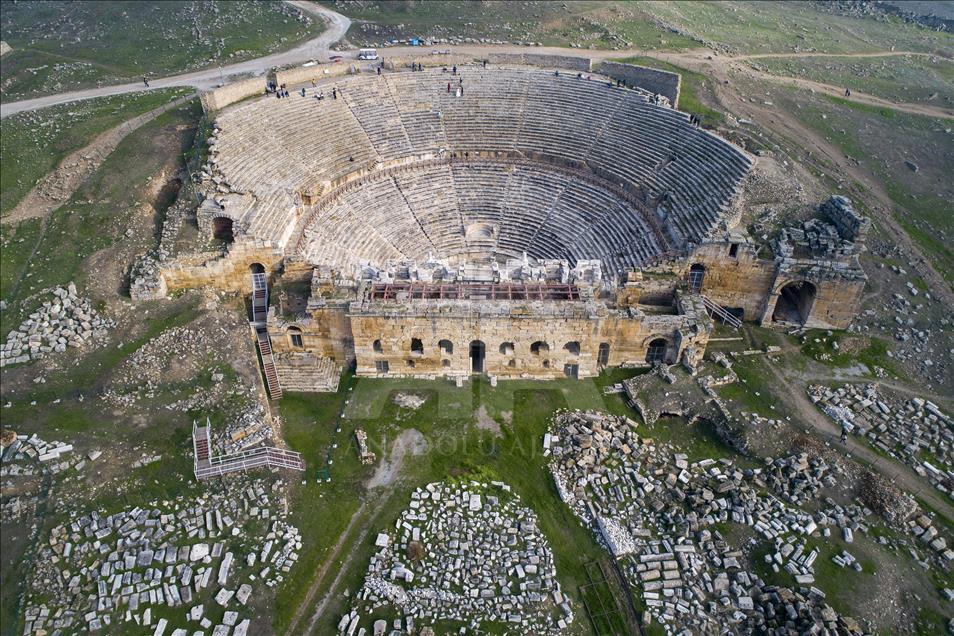
DENIZLI, TURKEY - DECEMBER 23: A view of ancient theatre at ancient city of Hierapolis on December 23, 2018 in Denizli, Turkey. The ancient city of Hierapolis is located on a 200 meter high terrace of limestone deposits amid a wonderland of mineral water pools and petrified limestone waterfalls. The ancient city overlooks the modern town of Pamukkale in Turkey's Inner Aegean region. Founded as a thermal spa in 190 BC by Eumenes II, the King of Pergamon, the city was most likely named for Hiero, the wife of the legendary founder of the Pergamene dynasty. The theatre at Hierapolis was built in the second century AD under the Roman Emperor Hadrian during a period of extensive rebuilding following a devastating earthquake in 60 AD. It was later renovated under Septimus Severus (193-211 AD). ( Emin Mengüarslan - Anadolu Agency )
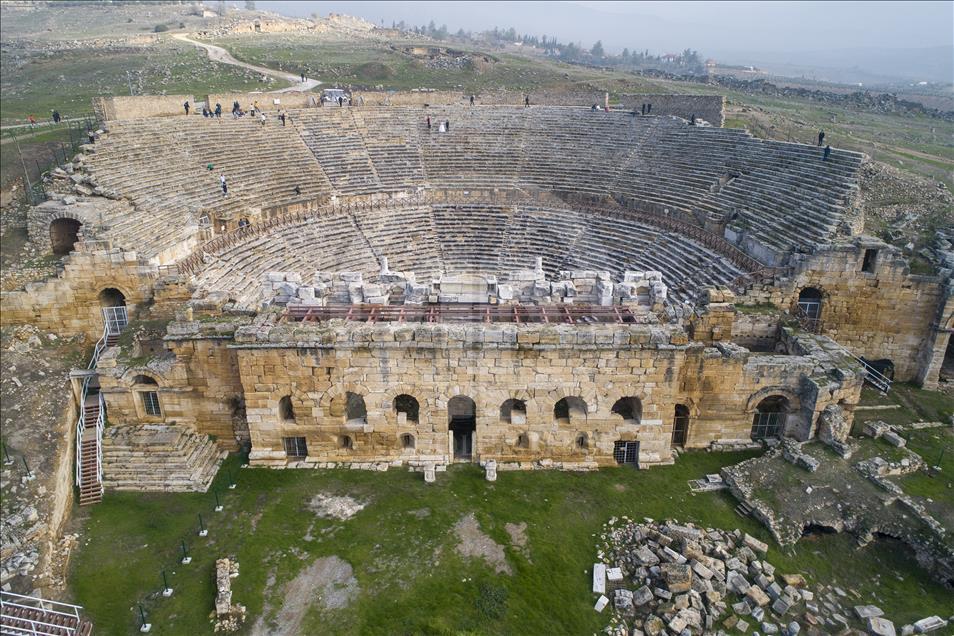
DENIZLI, TURKEY - DECEMBER 23: A view of ancient theatre at ancient city of Hierapolis on December 23, 2018 in Denizli, Turkey. The ancient city of Hierapolis is located on a 200 meter high terrace of limestone deposits amid a wonderland of mineral water pools and petrified limestone waterfalls. The ancient city overlooks the modern town of Pamukkale in Turkey's Inner Aegean region. Founded as a thermal spa in 190 BC by Eumenes II, the King of Pergamon, the city was most likely named for Hiero, the wife of the legendary founder of the Pergamene dynasty. The theatre at Hierapolis was built in the second century AD under the Roman Emperor Hadrian during a period of extensive rebuilding following a devastating earthquake in 60 AD. It was later renovated under Septimus Severus (193-211 AD). ( Emin Mengüarslan - Anadolu Agency )
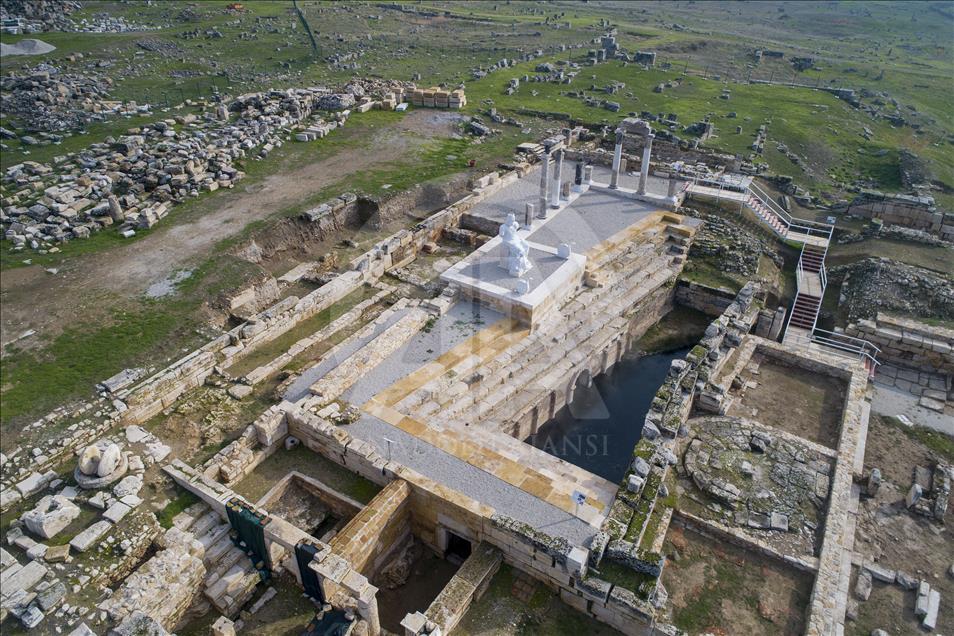
DENIZLI, TURKEY - DECEMBER 23: A view of ancient city of Hierapolis on December 23, 2018 in Denizli, Turkey. The ancient city of Hierapolis is located on a 200 meter high terrace of limestone deposits amid a wonderland of mineral water pools and petrified limestone waterfalls. The ancient city overlooks the modern town of Pamukkale in Turkey's Inner Aegean region. Founded as a thermal spa in 190 BC by Eumenes II, the King of Pergamon, the city was most likely named for Hiero, the wife of the legendary founder of the Pergamene dynasty. ( Emin Mengüarslan - Anadolu Agency )
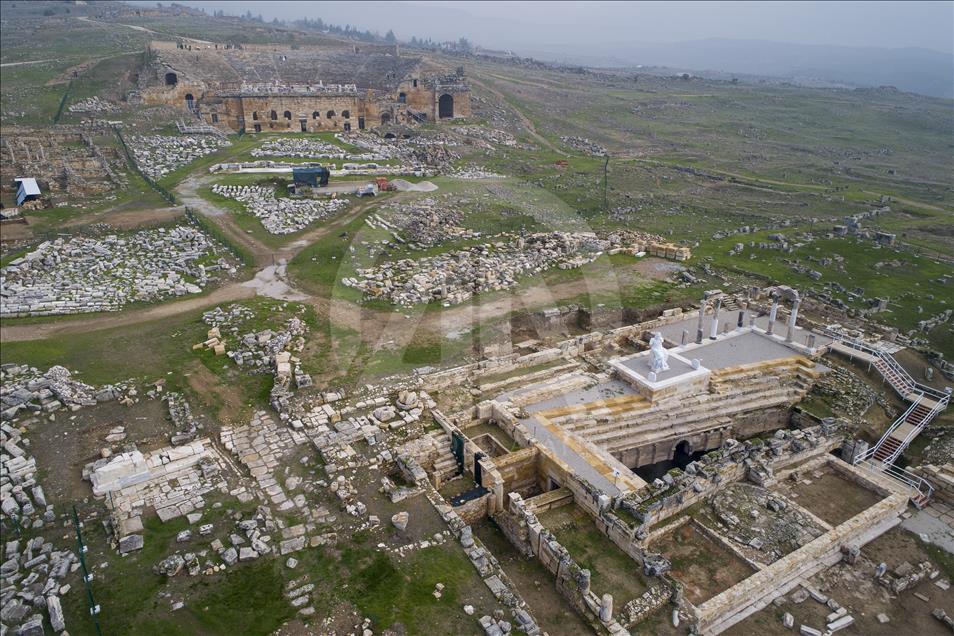
DENIZLI, TURKEY - DECEMBER 23: A view of ancient city of Hierapolis on December 23, 2018 in Denizli, Turkey. The ancient city of Hierapolis is located on a 200 meter high terrace of limestone deposits amid a wonderland of mineral water pools and petrified limestone waterfalls. The ancient city overlooks the modern town of Pamukkale in Turkey's Inner Aegean region. Founded as a thermal spa in 190 BC by Eumenes II, the King of Pergamon, the city was most likely named for Hiero, the wife of the legendary founder of the Pergamene dynasty. ( Emin Mengüarslan - Anadolu Agency )
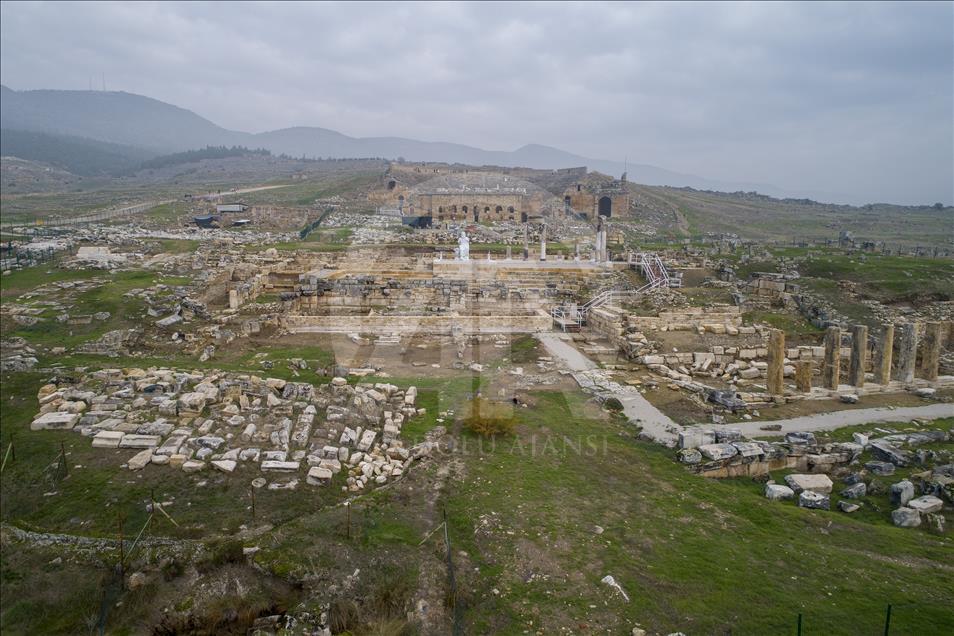
DENIZLI, TURKEY - DECEMBER 23: A view of ancient city of Hierapolis on December 23, 2018 in Denizli, Turkey. The ancient city of Hierapolis is located on a 200 meter high terrace of limestone deposits amid a wonderland of mineral water pools and petrified limestone waterfalls. The ancient city overlooks the modern town of Pamukkale in Turkey's Inner Aegean region. Founded as a thermal spa in 190 BC by Eumenes II, the King of Pergamon, the city was most likely named for Hiero, the wife of the legendary founder of the Pergamene dynasty. ( Emin Mengüarslan - Anadolu Agency )
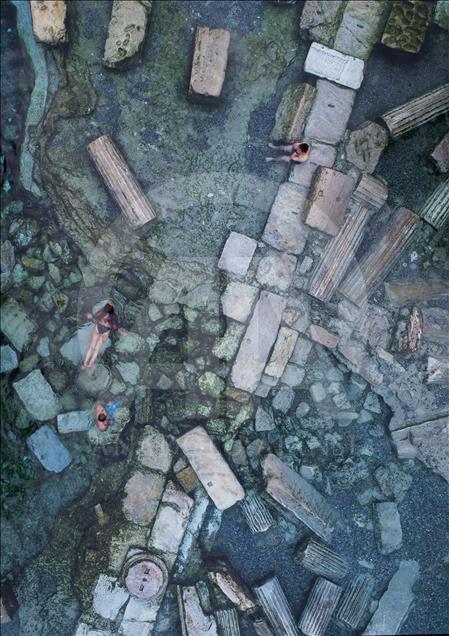
DENIZLI, TURKEY - DECEMBER 23: A view of tourists at the Cleopatra's Pool in the ruins of ancient city of Hierapolis at the UNESCO World Heritage Site of Pamukkale on December 23, 2018 in Denizli, Turkey. Thermal water have been running at Pamukkale for 2500 years. Pamukkale, literally "Cotton Castle" in Turkish, is also the site of the well-preserved ruins of the Greek-Roman city of Hierapolis. With a unique combination of natural and man-made wonders Pamukkale-Hierapolis has been made a Unesco World Heritage site. With over two million visitors annually, it is also one of the Turkey’s most visited attractions. ( Emin Mengüarslan - Anadolu Agency )
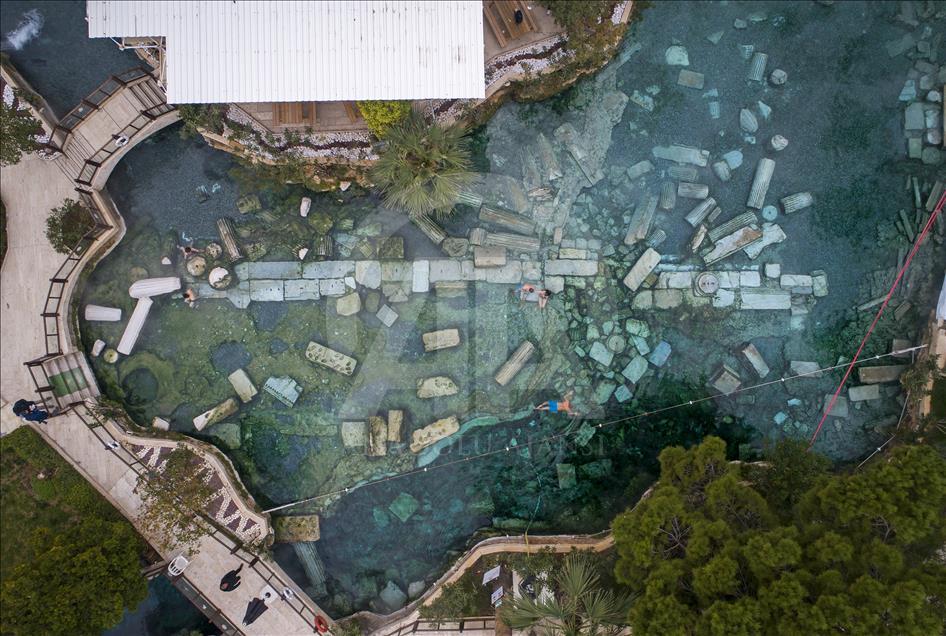
DENIZLI, TURKEY - DECEMBER 23: A view of tourists at the Cleopatra's Pool in the ruins of ancient city of Hierapolis at the UNESCO World Heritage Site of Pamukkale on December 23, 2018 in Denizli, Turkey. Thermal water have been running at Pamukkale for 2500 years. Pamukkale, literally "Cotton Castle" in Turkish, is also the site of the well-preserved ruins of the Greek-Roman city of Hierapolis. With a unique combination of natural and man-made wonders Pamukkale-Hierapolis has been made a Unesco World Heritage site. With over two million visitors annually, it is also one of the Turkey’s most visited attractions. ( Emin Mengüarslan - Anadolu Agency )
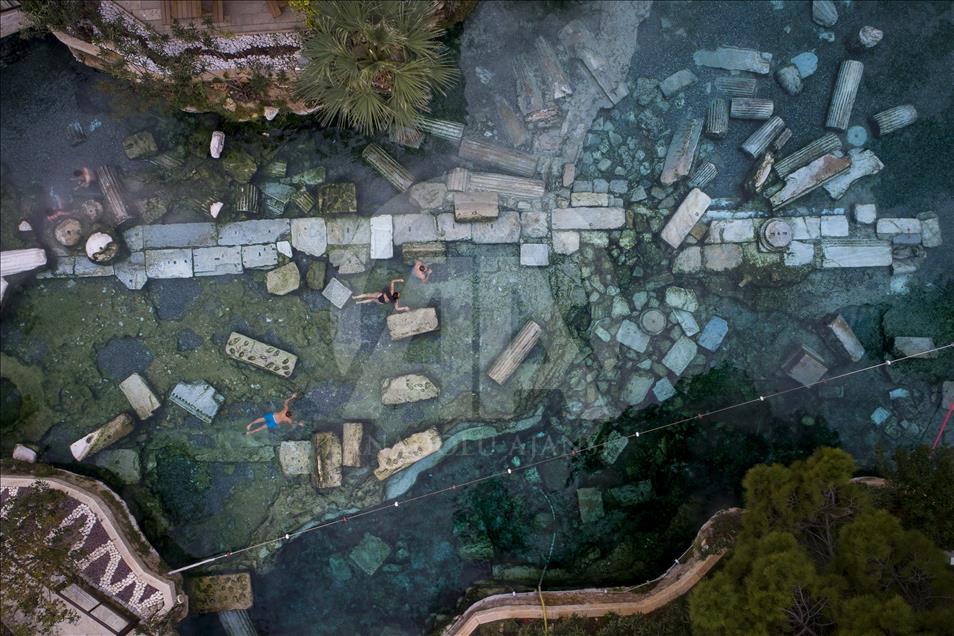
DENIZLI, TURKEY - DECEMBER 23: A view of tourists at the Cleopatra's Pool in the ruins of ancient city of Hierapolis at the UNESCO World Heritage Site of Pamukkale on December 23, 2018 in Denizli, Turkey. Thermal water have been running at Pamukkale for 2500 years. Pamukkale, literally "Cotton Castle" in Turkish, is also the site of the well-preserved ruins of the Greek-Roman city of Hierapolis. With a unique combination of natural and man-made wonders Pamukkale-Hierapolis has been made a Unesco World Heritage site. With over two million visitors annually, it is also one of the Turkey’s most visited attractions. ( Emin Mengüarslan - Anadolu Agency )
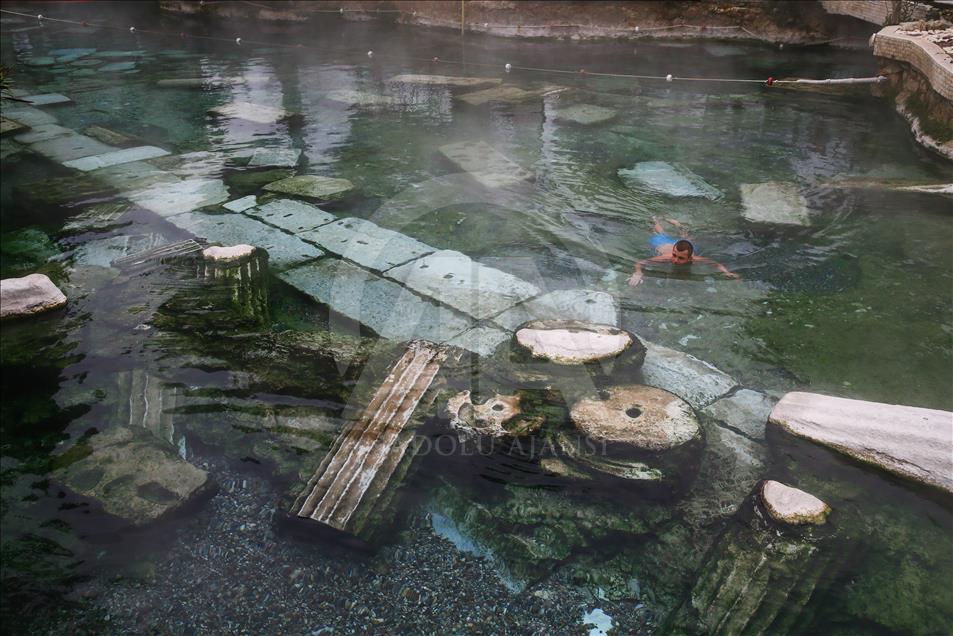
DENIZLI, TURKEY - DECEMBER 23: A view of tourists at the Cleopatra's Pool in the ruins of ancient city of Hierapolis at the UNESCO World Heritage Site of Pamukkale on December 23, 2018 in Denizli, Turkey. Thermal water have been running at Pamukkale for 2500 years. Pamukkale, literally "Cotton Castle" in Turkish, is also the site of the well-preserved ruins of the Greek-Roman city of Hierapolis. With a unique combination of natural and man-made wonders Pamukkale-Hierapolis has been made a Unesco World Heritage site. With over two million visitors annually, it is also one of the Turkey’s most visited attractions. ( Emin Mengüarslan - Anadolu Agency )

DENIZLI, TURKEY - DECEMBER 23: A view of tourists at the Cleopatra's Pool in the ruins of ancient city of Hierapolis at the UNESCO World Heritage Site of Pamukkale on December 23, 2018 in Denizli, Turkey. Thermal water have been running at Pamukkale for 2500 years. Pamukkale, literally "Cotton Castle" in Turkish, is also the site of the well-preserved ruins of the Greek-Roman city of Hierapolis. With a unique combination of natural and man-made wonders Pamukkale-Hierapolis has been made a Unesco World Heritage site. With over two million visitors annually, it is also one of the Turkey’s most visited attractions. ( Emin Mengüarslan - Anadolu Agency )

DENIZLI, TURKEY - DECEMBER 23: A view of tourists at the Cleopatra's Pool in the ruins of ancient city of Hierapolis at the UNESCO World Heritage Site of Pamukkale on December 23, 2018 in Denizli, Turkey. Thermal water have been running at Pamukkale for 2500 years. Pamukkale, literally "Cotton Castle" in Turkish, is also the site of the well-preserved ruins of the Greek-Roman city of Hierapolis. With a unique combination of natural and man-made wonders Pamukkale-Hierapolis has been made a Unesco World Heritage site. With over two million visitors annually, it is also one of the Turkey’s most visited attractions. ( Emin Mengüarslan - Anadolu Agency )

DENIZLI, TURKEY - DECEMBER 23: A view of tourists at the Cleopatra's Pool in the ruins of ancient city of Hierapolis at the UNESCO World Heritage Site of Pamukkale on December 23, 2018 in Denizli, Turkey. Thermal water have been running at Pamukkale for 2500 years. Pamukkale, literally "Cotton Castle" in Turkish, is also the site of the well-preserved ruins of the Greek-Roman city of Hierapolis. With a unique combination of natural and man-made wonders Pamukkale-Hierapolis has been made a Unesco World Heritage site. With over two million visitors annually, it is also one of the Turkey’s most visited attractions. ( Emin Mengüarslan - Anadolu Agency )
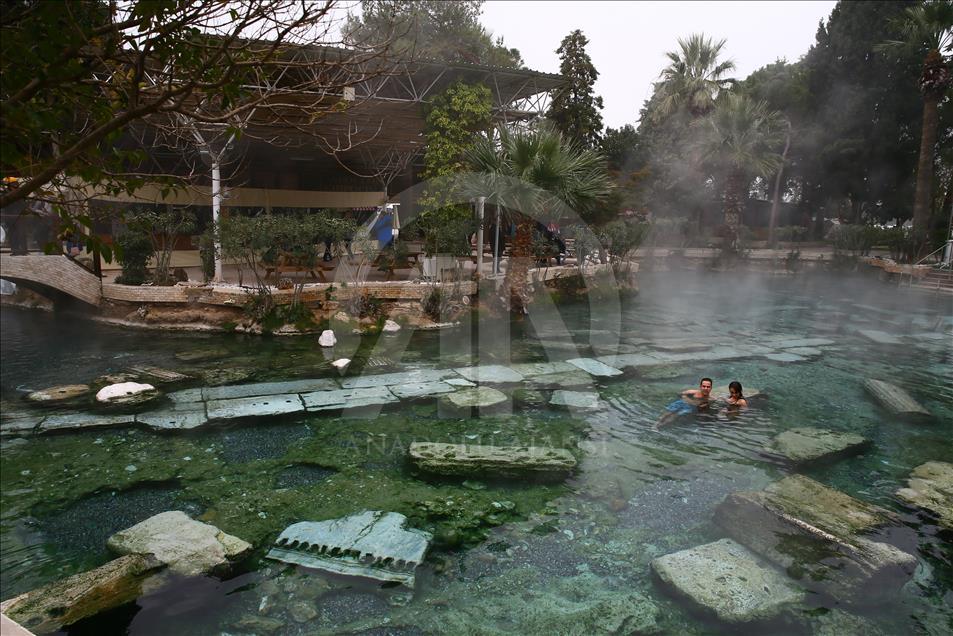
DENIZLI, TURKEY - DECEMBER 23: A view of tourists at the Cleopatra's Pool in the ruins of ancient city of Hierapolis at the UNESCO World Heritage Site of Pamukkale on December 23, 2018 in Denizli, Turkey. Thermal water have been running at Pamukkale for 2500 years. Pamukkale, literally "Cotton Castle" in Turkish, is also the site of the well-preserved ruins of the Greek-Roman city of Hierapolis. With a unique combination of natural and man-made wonders Pamukkale-Hierapolis has been made a Unesco World Heritage site. With over two million visitors annually, it is also one of the Turkey’s most visited attractions. ( Emin Mengüarslan - Anadolu Agency )

DENIZLI, TURKEY - DECEMBER 23: Tourists walk at the layers of limestones and travertines at the UNESCO World Heritage Site of Pamukkale in ancient city of Hierapolis on December 23, 2018 in Denizli, Turkey. Thermal water have been running at Pamukkale for 2500 years. Pamukkale, literally "Cotton Castle" in Turkish, is also the site of the well-preserved ruins of the Greek-Roman city of Hierapolis. With a unique combination of natural and man-made wonders Pamukkale-Hierapolis has been made a Unesco World Heritage site. With over two million visitors annually, it is also one of the Turkey’s most visited attractions. ( Emin Mengüarslan - Anadolu Agency )

DENIZLI, TURKEY - DECEMBER 23: A tourist poses for a photo at the layers of limestones and travertines at the UNESCO World Heritage Site of Pamukkale in ancient city of Hierapolis on December 23, 2018 in Denizli, Turkey. Thermal water have been running at Pamukkale for 2500 years. Pamukkale, literally "Cotton Castle" in Turkish, is also the site of the well-preserved ruins of the Greek-Roman city of Hierapolis. With a unique combination of natural and man-made wonders Pamukkale-Hierapolis has been made a Unesco World Heritage site. With over two million visitors annually, it is also one of the Turkey’s most visited attractions. ( Emin Mengüarslan - Anadolu Agency )
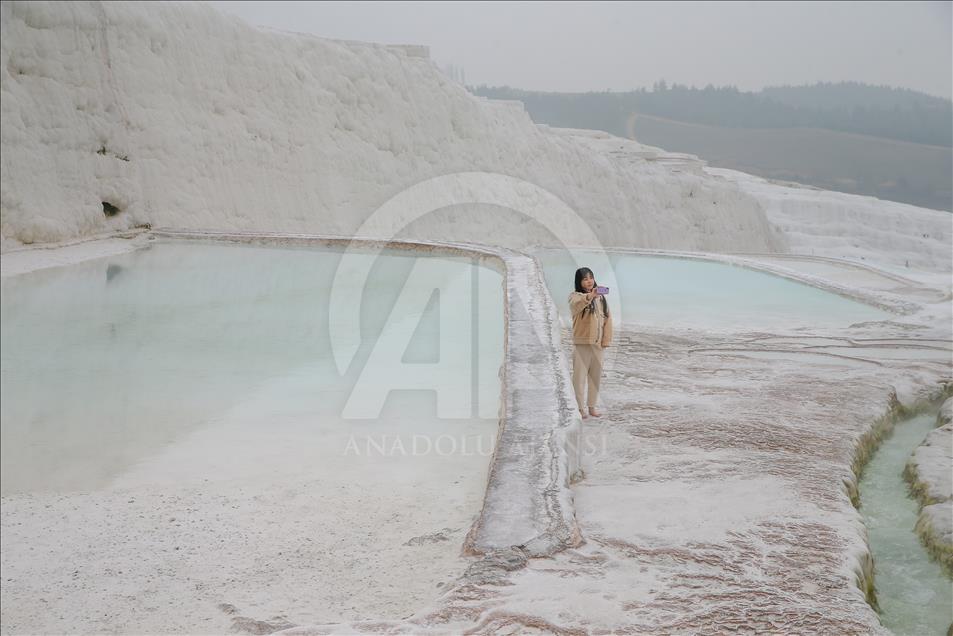
DENIZLI, TURKEY - DECEMBER 23: A tourists takes a photo at the layers of limestones and travertines at the UNESCO World Heritage Site of Pamukkale in ancient city of Hierapolis on December 23, 2018 in Denizli, Turkey. Thermal water have been running at Pamukkale for 2500 years. Pamukkale, literally "Cotton Castle" in Turkish, is also the site of the well-preserved ruins of the Greek-Roman city of Hierapolis. With a unique combination of natural and man-made wonders Pamukkale-Hierapolis has been made a Unesco World Heritage site. With over two million visitors annually, it is also one of the Turkey’s most visited attractions. ( Emin Mengüarslan - Anadolu Agency )

DENIZLI, TURKEY - DECEMBER 23: Tourists take photo with a parrot at the layers of limestones and travertines at the UNESCO World Heritage Site of Pamukkale in ancient city of Hierapolis on December 23, 2018 in Denizli, Turkey. Thermal water have been running at Pamukkale for 2500 years. Pamukkale, literally "Cotton Castle" in Turkish, is also the site of the well-preserved ruins of the Greek-Roman city of Hierapolis. With a unique combination of natural and man-made wonders Pamukkale-Hierapolis has been made a Unesco World Heritage site. With over two million visitors annually, it is also one of the Turkey’s most visited attractions. ( Emin Mengüarslan - Anadolu Agency )
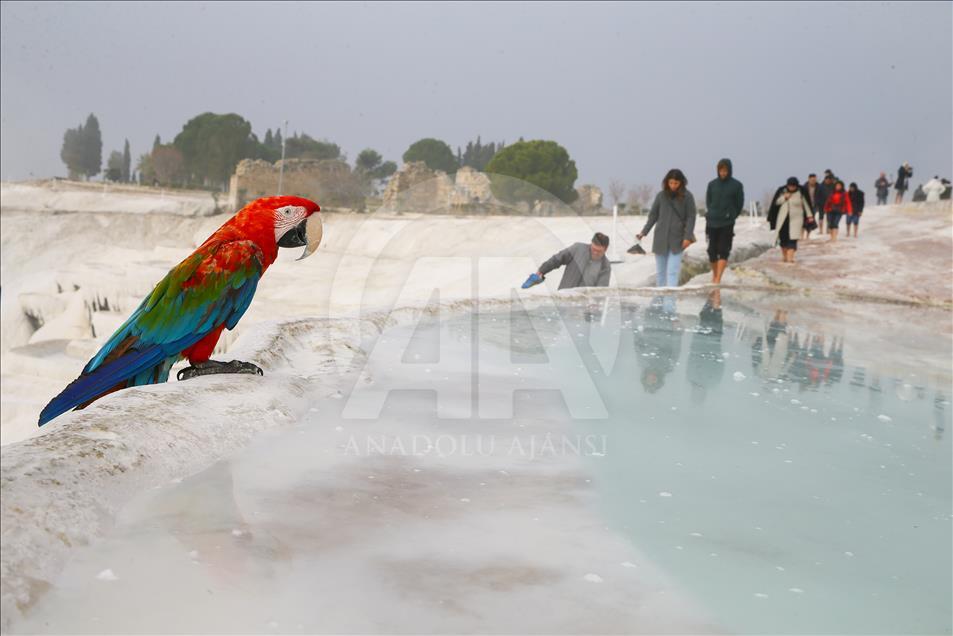
DENIZLI, TURKEY - DECEMBER 23: A parrot is seen at the layers of limestones and travertines at the UNESCO World Heritage Site of Pamukkale in ancient city of Hierapolis on December 23, 2018 in Denizli, Turkey. Thermal water have been running at Pamukkale for 2500 years. Pamukkale, literally "Cotton Castle" in Turkish, is also the site of the well-preserved ruins of the Greek-Roman city of Hierapolis. With a unique combination of natural and man-made wonders Pamukkale-Hierapolis has been made a Unesco World Heritage site. With over two million visitors annually, it is also one of the Turkey’s most visited attractions. ( Emin Mengüarslan - Anadolu Agency )

DENIZLI, TURKEY - DECEMBER 23: A drone photo shows an aerial view of the layers of limestones and travertines at the UNESCO World Heritage Site of Pamukkale in ancient city of Hierapolis on December 23, 2018 in Denizli, Turkey. Thermal water have been running at Pamukkale for 2500 years. Pamukkale, literally "Cotton Castle" in Turkish, is also the site of the well-preserved ruins of the Greek-Roman city of Hierapolis. With a unique combination of natural and man-made wonders Pamukkale-Hierapolis has been made a Unesco World Heritage site. With over two million visitors annually, it is also one of the Turkey’s most visited attractions. ( Emin Mengüarslan - Anadolu Agency )
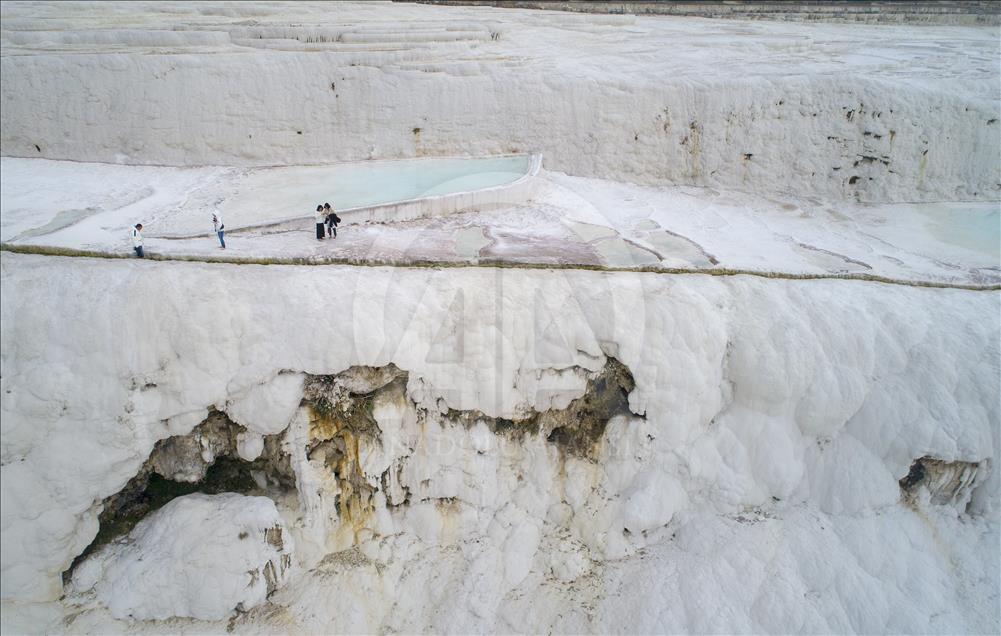
DENIZLI, TURKEY - DECEMBER 23: A drone photo shows an aerial view of the layers of limestones and travertines at the UNESCO World Heritage Site of Pamukkale in ancient city of Hierapolis on December 23, 2018 in Denizli, Turkey. Thermal water have been running at Pamukkale for 2500 years. Pamukkale, literally "Cotton Castle" in Turkish, is also the site of the well-preserved ruins of the Greek-Roman city of Hierapolis. With a unique combination of natural and man-made wonders Pamukkale-Hierapolis has been made a Unesco World Heritage site. With over two million visitors annually, it is also one of the Turkey’s most visited attractions. ( Emin Mengüarslan - Anadolu Agency )
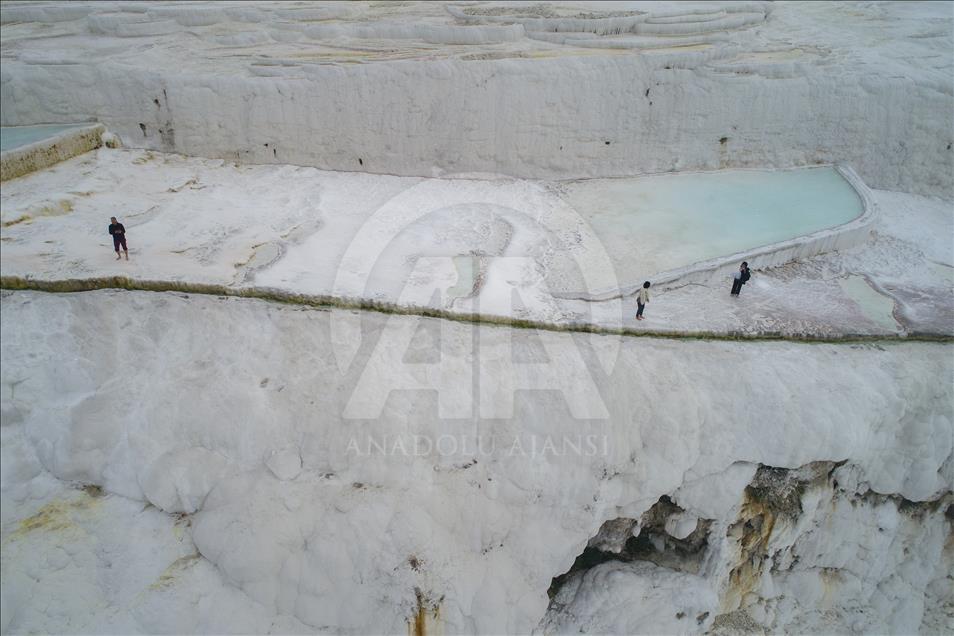
DENIZLI, TURKEY - DECEMBER 23: A drone photo shows an aerial view of the layers of limestones and travertines at the UNESCO World Heritage Site of Pamukkale in ancient city of Hierapolis on December 23, 2018 in Denizli, Turkey. Thermal water have been running at Pamukkale for 2500 years. Pamukkale, literally "Cotton Castle" in Turkish, is also the site of the well-preserved ruins of the Greek-Roman city of Hierapolis. With a unique combination of natural and man-made wonders Pamukkale-Hierapolis has been made a Unesco World Heritage site. With over two million visitors annually, it is also one of the Turkey’s most visited attractions. ( Emin Mengüarslan - Anadolu Agency )
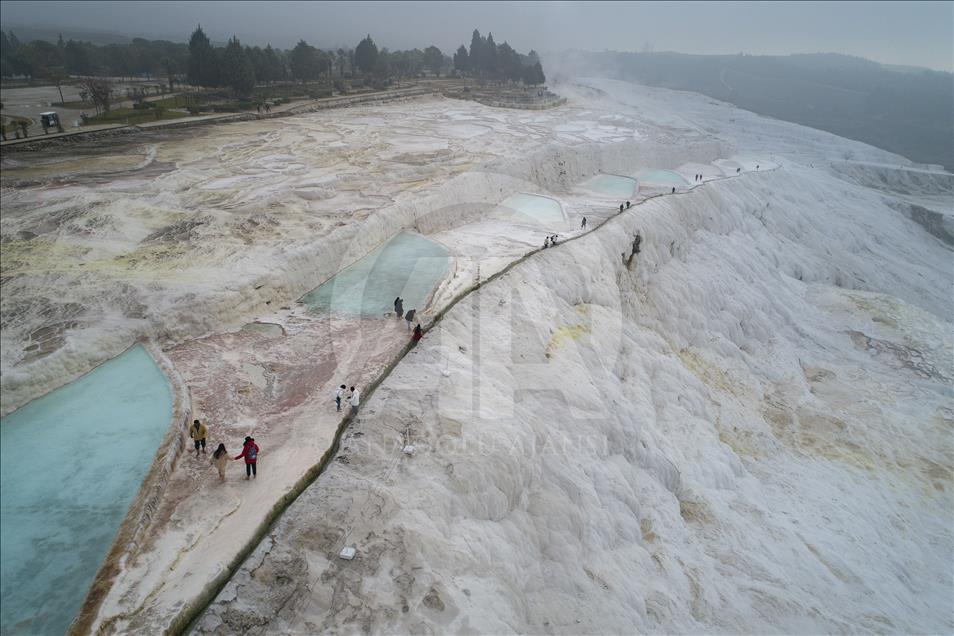
DENIZLI, TURKEY - DECEMBER 23: A drone photo shows an aerial view of the layers of limestones and travertines at the UNESCO World Heritage Site of Pamukkale in ancient city of Hierapolis on December 23, 2018 in Denizli, Turkey. Thermal water have been running at Pamukkale for 2500 years. Pamukkale, literally "Cotton Castle" in Turkish, is also the site of the well-preserved ruins of the Greek-Roman city of Hierapolis. With a unique combination of natural and man-made wonders Pamukkale-Hierapolis has been made a Unesco World Heritage site. With over two million visitors annually, it is also one of the Turkey’s most visited attractions. ( Emin Mengüarslan - Anadolu Agency )

DENIZLI, TURKEY - DECEMBER 23: A drone photo shows an aerial view of the layers of limestones and travertines at the UNESCO World Heritage Site of Pamukkale in ancient city of Hierapolis on December 23, 2018 in Denizli, Turkey. Thermal water have been running at Pamukkale for 2500 years. Pamukkale, literally "Cotton Castle" in Turkish, is also the site of the well-preserved ruins of the Greek-Roman city of Hierapolis. With a unique combination of natural and man-made wonders Pamukkale-Hierapolis has been made a Unesco World Heritage site. With over two million visitors annually, it is also one of the Turkey’s most visited attractions. ( Emin Mengüarslan - Anadolu Agency )
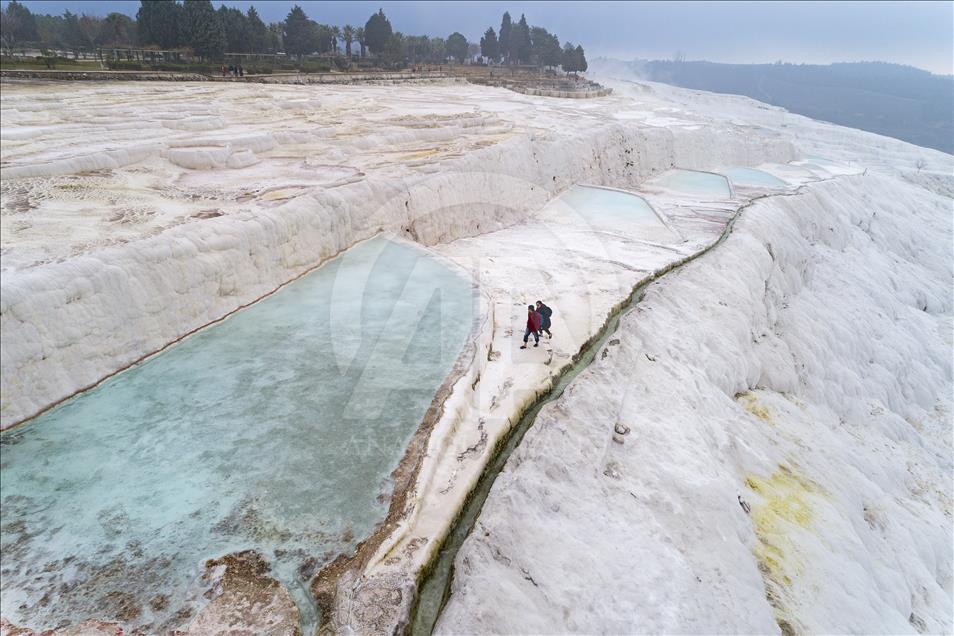
DENIZLI, TURKEY - DECEMBER 23: A drone photo shows an aerial view of the layers of limestones and travertines at the UNESCO World Heritage Site of Pamukkale in ancient city of Hierapolis on December 23, 2018 in Denizli, Turkey. Thermal water have been running at Pamukkale for 2500 years. Pamukkale, literally "Cotton Castle" in Turkish, is also the site of the well-preserved ruins of the Greek-Roman city of Hierapolis. With a unique combination of natural and man-made wonders Pamukkale-Hierapolis has been made a Unesco World Heritage site. With over two million visitors annually, it is also one of the Turkey’s most visited attractions. ( Emin Mengüarslan - Anadolu Agency )
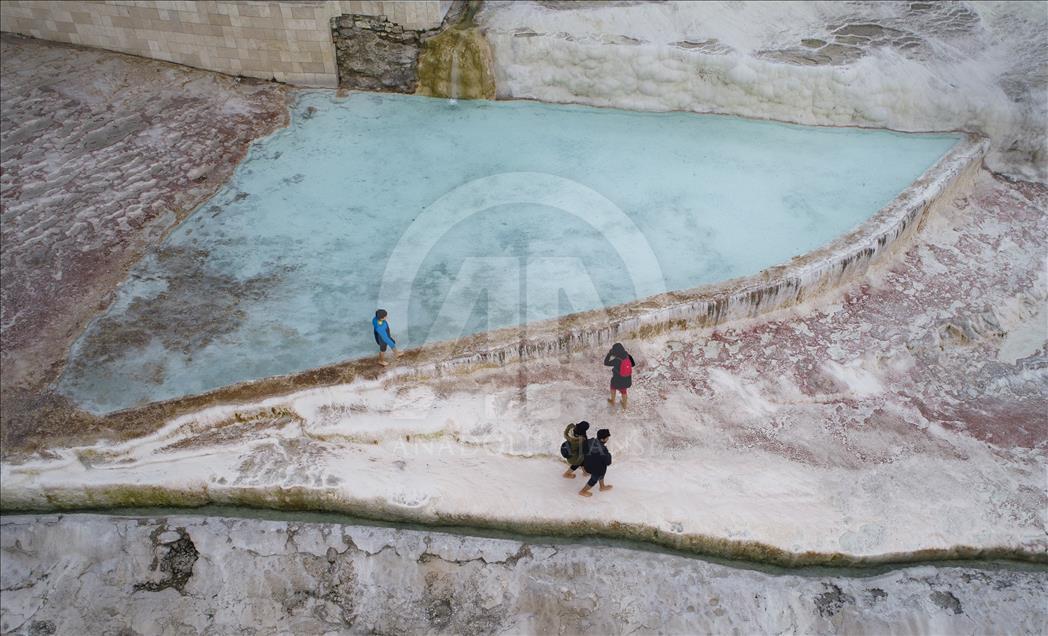
DENIZLI, TURKEY - DECEMBER 23: A drone photo shows an aerial view of the layers of limestones and travertines at the UNESCO World Heritage Site of Pamukkale in ancient city of Hierapolis on December 23, 2018 in Denizli, Turkey. Thermal water have been running at Pamukkale for 2500 years. Pamukkale, literally "Cotton Castle" in Turkish, is also the site of the well-preserved ruins of the Greek-Roman city of Hierapolis. With a unique combination of natural and man-made wonders Pamukkale-Hierapolis has been made a Unesco World Heritage site. With over two million visitors annually, it is also one of the Turkey’s most visited attractions. ( Emin Mengüarslan - Anadolu Agency )

DENIZLI, TURKEY - DECEMBER 23: A drone photo shows an aerial view of the layers of limestones and travertines at the UNESCO World Heritage Site of Pamukkale in ancient city of Hierapolis on December 23, 2018 in Denizli, Turkey. Thermal water have been running at Pamukkale for 2500 years. Pamukkale, literally "Cotton Castle" in Turkish, is also the site of the well-preserved ruins of the Greek-Roman city of Hierapolis. With a unique combination of natural and man-made wonders Pamukkale-Hierapolis has been made a Unesco World Heritage site. With over two million visitors annually, it is also one of the Turkey’s most visited attractions. ( Emin Mengüarslan - Anadolu Agency )


